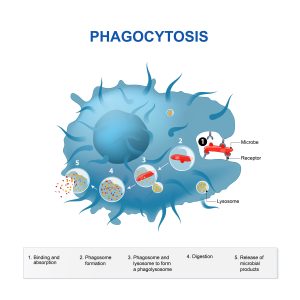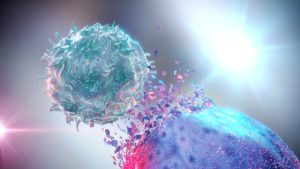Natural killer cells are lymphocytes belonging to the same family as B cells and T cells. They are cytotoxic cells of the innate immune system and circulate in the body seeking out infected and cancerous cells. When they encounter an abnormal cell, natural killer cells secrete cytotoxic granules to destroy the cell and limit the spread of infection or disease in the body.Natural killer cells are immune sentinels that roam the body seeking out infected and cancerous cells. For this reason, NK cells are widespread throughout the body and are found in most human tissues.
Natural killer cells destroy infected host cells and cancer cells
They are found in their highest concentrations in the bloodstream, the uterus, the lungs, and the liver. Natural killer cells develop from stem cells in the bone marrow, lymph nodes, the spleen, or the tonsils. Mature NK cells account for around 5-20% of circulating white blood cells in the human body.
The human immune system consists of various types of chemical barriers for defence or to prevent the invasion of pathogens. These are the phagocytes and killer cells..
Both types are constantly active in the cellular defence within the scope of their capacity, consequently they directly take up pathogens and foreign bodies, destroy them or transport them away.

- Phagocytes belong to the leucocytes or white blood cells, which eat up the pathogen, after which what remains of it is transported to the cell surface, where the specific immune system then also carries out the further immune defence assigned to it.
- Natural killer cells become active in a different sequence, particularly in the case of viruses and tumour-like cells. If they recognise such cell types, then a production immediately occurs to create special cell poisons, which then destroy the viruses or tumour cells.
If the specific immune system is explained in more detail, then it is to be said that it fights specific pathogens in a very targeted manner. It is important to note that if it is to do its job well, it must first ‘get to know’ the pathogen, which means that identification is necessary. A direct ‘confrontation’, so to speak, takes place between the immune system and the pathogen, whereupon, after identification, the immune system responds by producing special defence cells that serve to destroy the pathogen. This means that the immune system’s reaction takes a little longer, because the first contact with a pathogen actually requires clarification as to what kind of invader it is. As is common everywhere, once something has been recognised or experienced, it is also the case with the immune system that on further contact with the same pathogen, it is recognised, consequently the system reacts more effectively and immediately takes countermeasures against it.
The reason why the specific immune system protects the human body against certain diseases in this way is that the symptoms of the disease are significantly weaker or do not appear at all in the event of further contact with the pathogen. The immune system, which has learned everything it can about a pathogen through the first attack, then continues to work with the help of 2 types of cells, namely:
- The T-cells or T-lymphocytes, which the human body has in the bone marrow, but which migrate from there to the thymus to mature and are then deposited in the tissue. In their fight against pathogens, the T cells perform 3 different tasks, namely as:
T-helper cells, which basically initiate the defence reaction in the body,
T-killer cells, which recognise and destroy infected cells and also tumour cells,
T-memory cells, which ensure that the specific immune system directly identifies the specific pathogen already infected once on the next contact and can react quickly against it.
- B cells or B lymphocytes are also formed in the bone marrow, and they remain there to mature. Like the T-cells, the B-cells also have names from the place where they mature. The B-cells are always targeted at a particular pathogen, but they only form on that pathogen when the body has contact with it. The B cells are also activated by the T helper cells, and this happens when the pathogen enters the body and matches the B cell. The T-cells in turn then sound the alarm, causing the B-cells to multiply rapidly and transform into plasma cells, which in turn produce numerous antibodies or immunoglobulins/proteins within a very short time that render the pathogen harmless.
